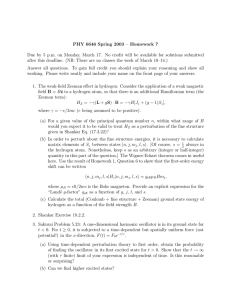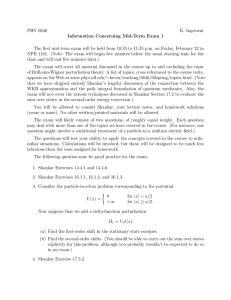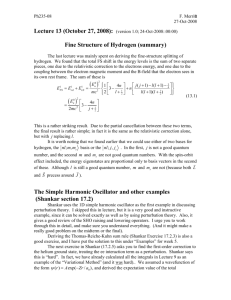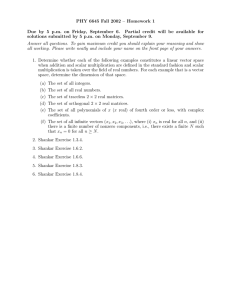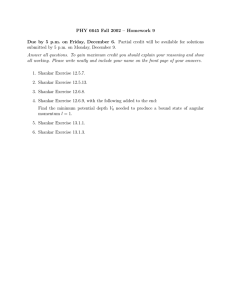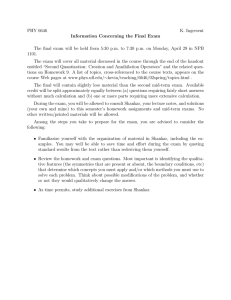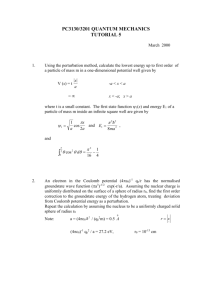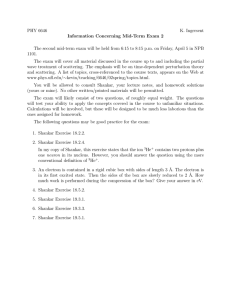PHY 6646 Spring 2002 – Homework 6
advertisement
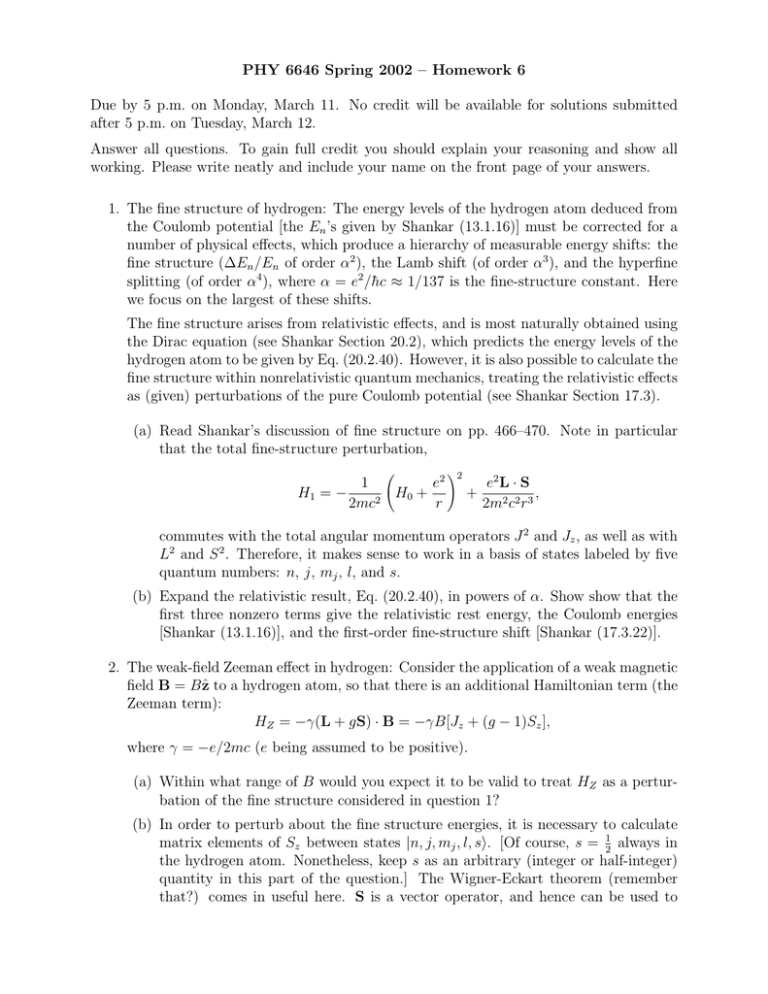
PHY 6646 Spring 2002 – Homework 6 Due by 5 p.m. on Monday, March 11. No credit will be available for solutions submitted after 5 p.m. on Tuesday, March 12. Answer all questions. To gain full credit you should explain your reasoning and show all working. Please write neatly and include your name on the front page of your answers. 1. The fine structure of hydrogen: The energy levels of the hydrogen atom deduced from the Coulomb potential [the En ’s given by Shankar (13.1.16)] must be corrected for a number of physical effects, which produce a hierarchy of measurable energy shifts: the fine structure (∆En /En of order α2 ), the Lamb shift (of order α3 ), and the hyperfine splitting (of order α4 ), where α = e2 /h̄c ≈ 1/137 is the fine-structure constant. Here we focus on the largest of these shifts. The fine structure arises from relativistic effects, and is most naturally obtained using the Dirac equation (see Shankar Section 20.2), which predicts the energy levels of the hydrogen atom to be given by Eq. (20.2.40). However, it is also possible to calculate the fine structure within nonrelativistic quantum mechanics, treating the relativistic effects as (given) perturbations of the pure Coulomb potential (see Shankar Section 17.3). (a) Read Shankar’s discussion of fine structure on pp. 466–470. Note in particular that the total fine-structure perturbation, 1 e2 H + H1 = − 0 2mc2 r !2 + e2 L · S , 2m2 c2 r3 commutes with the total angular momentum operators J 2 and Jz , as well as with L2 and S 2 . Therefore, it makes sense to work in a basis of states labeled by five quantum numbers: n, j, mj , l, and s. (b) Expand the relativistic result, Eq. (20.2.40), in powers of α. Show show that the first three nonzero terms give the relativistic rest energy, the Coulomb energies [Shankar (13.1.16)], and the first-order fine-structure shift [Shankar (17.3.22)]. 2. The weak-field Zeeman effect in hydrogen: Consider the application of a weak magnetic field B = Bẑ to a hydrogen atom, so that there is an additional Hamiltonian term (the Zeeman term): HZ = −γ(L + gS) · B = −γB[Jz + (g − 1)Sz ], where γ = −e/2mc (e being assumed to be positive). (a) Within what range of B would you expect it to be valid to treat HZ as a perturbation of the fine structure considered in question 1? (b) In order to perturb about the fine structure energies, it is necessary to calculate matrix elements of Sz between states |n, j, mj , l, si. [Of course, s = 12 always in the hydrogen atom. Nonetheless, keep s as an arbitrary (integer or half-integer) quantity in this part of the question.] The Wigner-Eckart theorem (remember that?) comes in useful here. S is a vector operator, and hence can be used to construct a rank-1 spherical tensor. Apply Shankar (15.3.19) and the fact that J·S = 12 [J2 +S2 −(J−S)2 ] to show that the first-order energy shift can be written hn, j, mj , l, s|Hz |n, j, mj , l, si = geff µB Bmj , where µB = eh̄/2mc is the Bohr magneton. Provide an explicit expression for the “Landé g-factor” geff as a function of g, j, l, and s. (c) Calculate the total ground state energy of hydrogen as a function of the field strength B. 3. Ballentine Problem 10.14: The three-fold degenerate energy level of the hydrogen atom, with eigenvectors |n = 2, l = 1, m = ±1, 0i, is subjected to a perturbation of the form H1 = b(x2 − y 2 ), where b is a real scalar. Use degenerate perturbation theory to determine the zero-order eigenvectors and the splitting of the energy levels to the first order in b. (You need not evaluate the radial integrals that occur in the matrix elements of H1 , but you should determine which matrix elements are zero, which are nonzero, and which nonzero matrix elements are equal.) 4. Shankar Exercise 18.2.1. 5. Ballentine Problem 12.10: Consider a one-dimensional harmonic oscillator of angular frequency ω0 that is perturbed by the time-dependent potential V1 (t) = bx cos ωt, where x is the displacement of the oscillator from equilibrium. Evaluate hxi by first-order time-dependent perturbation theory. Discuss the validity of the result for ω ≈ ω0 and for ω far from ω0 .

